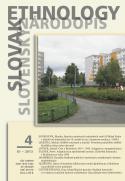ŽIDOVSKÁ KOMUNITA V BRATISLAVE PO ROKU 1945
THE JEWISH COMMUNITY IN BRATISLAVA AFTER 1945
Author(s): Peter SalnerSubject(s): Anthropology
Published by: SAV - Slovenská akadémia vied - Ústav etnológie a sociálnej antropológie Slovenskej akadémie vied
Keywords: adaptation; consequences of the Shoa, Zionist movement, Jewish religious community, the present time
Summary/Abstract: The paper is concerned with the adaptation of members of the Jewish community in Bratislava to the social changes which took place in Czechoslovakia after 1945. The author illustrates the consequences of the Shoa on the demographic structure of the community, forms of the family and value orientations of individuals. He takes note of the attempt of Orthodox believers at a renewal of religious life, but also the conflicts in opinions between traditionally and secularly orientated members of the Jewish Religious Community (ŽNO). He also devotes attention to the Zionist movement. In the second half of the 1940s this played an important role because, particularly for younger people, its ideology replaced religion in the system of values. After the accession to power of the Communist Party the community was obliged to adapt once again to a totalitarian regime. The response to August 1968 was a mass emigration of the younger and middle generation, which notably restricted the activities of the community in the subsequent period. In the period of normalisation the ŽNO, as a “community under control”, concentrated only on basic religious activities. The final part of the study briefly focuses on the situation after November 1989. At that time there was a vigorous attempt at revitalisation. However, the centre of attention was social and cultural activities, not religious life.
Journal: Slovenský národopis
- Issue Year: 61/2013
- Issue No: 4
- Page Range: 379-391
- Page Count: 13
- Language: Slovak

